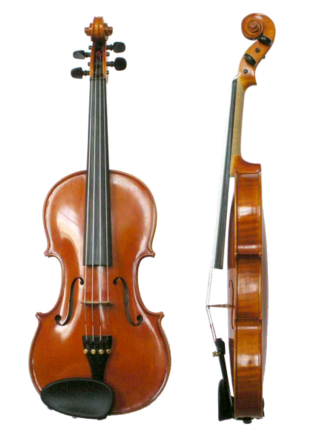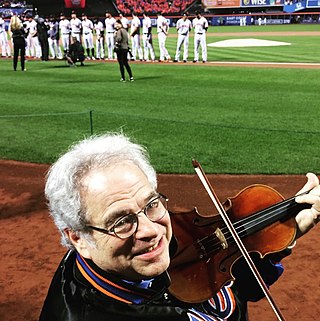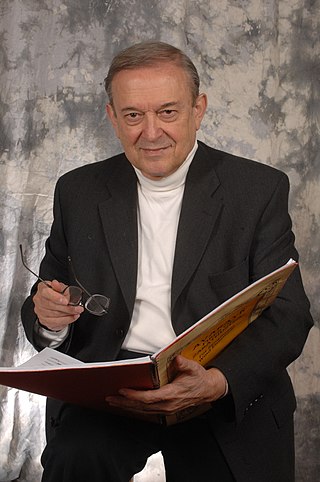
The double bass, also known simply as the bass, amongst other names, is the largest and, therefore, lowest-pitched chordophone in the modern symphony orchestra. Similar in structure to the cello, it has four, although occasionally five, strings.

The violin, sometimes known as a fiddle, is a wooden chordophone in the violin family. Most violins have a hollow wooden body. It is the smallest and thus highest-pitched instrument (soprano) in the family in regular use. The violin typically has four strings, usually tuned in perfect fifths with notes G3, D4, A4, E5, and is most commonly played by drawing a bow across its strings. It can also be played by plucking the strings with the fingers (pizzicato) and, in specialized cases, by striking the strings with the wooden side of the bow.

String instruments, stringed instruments, or chordophones are musical instruments that produce sound from vibrating strings when a performer plays or sounds the strings in some manner.

Pizzicato is a playing technique that involves plucking the strings of a string instrument. The exact technique varies somewhat depending on the type of instrument:
Ellen Taaffe Zwilich is an American composer, the first female composer to win the Pulitzer Prize for Music. Her early works are marked by atonal exploration, but by the late 1980s, she had shifted to a postmodernist, neoromantic style. She has been called "one of America's most frequently played and genuinely popular living composers." She was a 1994 inductee into the Florida Artists Hall of Fame. Zwilich has served as the Francis Eppes Distinguished Professor at Florida State University.

Itzhak Perlman is an Israeli-American violinist. He has performed worldwide and throughout the United States, in venues that have included a state dinner for Elizabeth II at the White House in 2007, and at the 2009 inauguration of Barack Obama. He has conducted the Detroit Symphony Orchestra, the Philadelphia Orchestra, and the Westchester Philharmonic. In 2015, he was awarded the Presidential Medal of Freedom. Perlman has won 16 Grammy Awards, including a Grammy Lifetime Achievement Award, and four Emmy Awards.

The erhu is a Chinese two-stringed bowed musical instrument, more specifically a spike fiddle, which may also be called a Southern Fiddle, and is sometimes known in the Western world as the Chinese violin or a Chinese two-stringed fiddle.
Lyndon Kent Lawless is an American musician and music educator best known for his creation and leadership of the Ars Musica period instrument chamber orchestra. He also developed and conducted the nationally known Youth Performing Arts School Philharmonia Orchestra.
Lya W. Stern is a violinist, recording artist and violin teacher. Born Lya Weiss to a Jewish family in Cluj, Romania, Stern moved to the United States as a teenager. She is married to Larry Stern and has two children.

Mark Winthrop Wood is an American electric violinist and the founder of Wood Violins, a company that manufactures his electric violin designs. His music education program, Electrify Your Symphony, has been featured on news programs nationwide. He is also an Emmy-winning composer and the original string master of the Trans-Siberian Orchestra.
The Mariam Cannon Hayes School of Music is the music school of Appalachian State University, a public university in Boone, North Carolina. It is accredited by the National Association of Schools of Music and offers undergraduate programs as well as Master's degree programs. The Hayes school of music is housed within the Broyhill Music Center, a 90,000+ square foot complex.
Fredell Lack was an American violinist. Noted as a concert soloist, recording artist, chamber musician, and teacher, she was the C. W. Moores Distinguished Professor of Violin at the Moores School of Music at the University of Houston in Houston, Texas.

Paul Doktor was a notable violist and orchestra conductor.
Brett Dean is an Australian composer, violist and conductor.
Benoît Marie Rolland, is a bow maker and musician, currently established in Boston, Massachusetts. An internationally renowned bow maker, he is a 2012 MacArthur Fellow and a Chevalier des Arts et des Lettres (2017).

Loris Ohannes Chobanian was an American-Armenian composer of classical music, conductor, and guitar and lute teacher and performer. He served as Professor of Composition as well as Composer-in-Residence at Baldwin-Wallace College Conservatory.
The National Association for Music Education (NAfME) is an organization of American music educators dedicated to advancing and preserving music education as part of the core curriculum of schools in the United States. Founded in 1907 as the Music Supervisors National Conference (MSNC), the organization was known from 1934 to 1998 as the Music Educators National Conference. From 1998 to 2011 it was known as "MENC: The National Association for Music Education." On September 1, 2011, the organization changed its acronym from MENC to NAfME. On March 8, 2012, the organization's name legally became National Association for Music Education, using the acronym "NAfME". It has approximately 45,000 members, and NAfME's headquarters are located in Reston, Virginia.

David Serkin Ludwig is an American composer, teacher, and Dean of Music at The Juilliard School. His uncle was pianist Peter Serkin, his grandfather was the pianist Rudolf Serkin, and his great-grandfather was the violinist Adolf Busch. He holds positions and residencies with nearly two dozen orchestras and music festivals in the US and abroad. His choral work, The New Colossus, was performed at the 2013 presidential inauguration of Barack Obama.
Julie Lyonn Lieberman is an American improvising violinist, vocalist, composer, author, educator, and recording artist specializing in fiddle and international violin styles. She is among the first to teach improvisation and world music at the Juilliard School. She also created the first eclectic styles teacher training program in the world as artistic director for the summer program, Strings Without Boundaries. Ms. Lieberman is an author, composer, producer, and performing artist.
Harvey Samuel Whistler Jr. was an American violinist, editor, arranger, and composer of educational music studies for studio, homogenous, and heterogeneous class instrumental instruction. In all, Whistler and colleagues published around 83 known educational music collections and methods for instrumental ensembles. Among his best known works are his violin and viola etude books, "Introducing the Positions," "Preparing for Kreutzer," "From Violin to Viola," and "Developing Double Stops" all of which were published by the Rubank, Inc. music publishing company, and are still available through the Hal Leonard Co.










